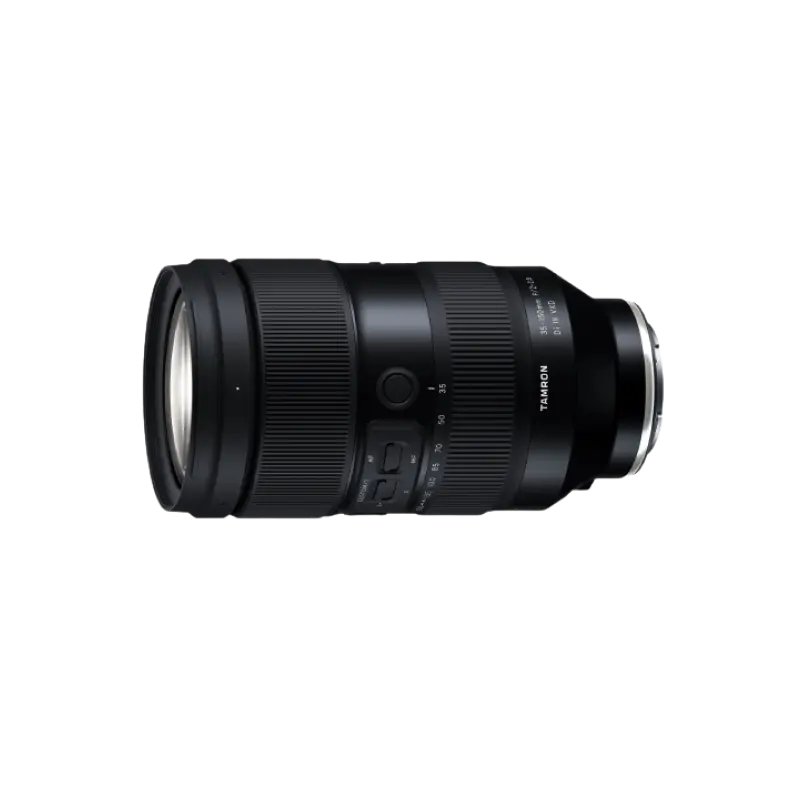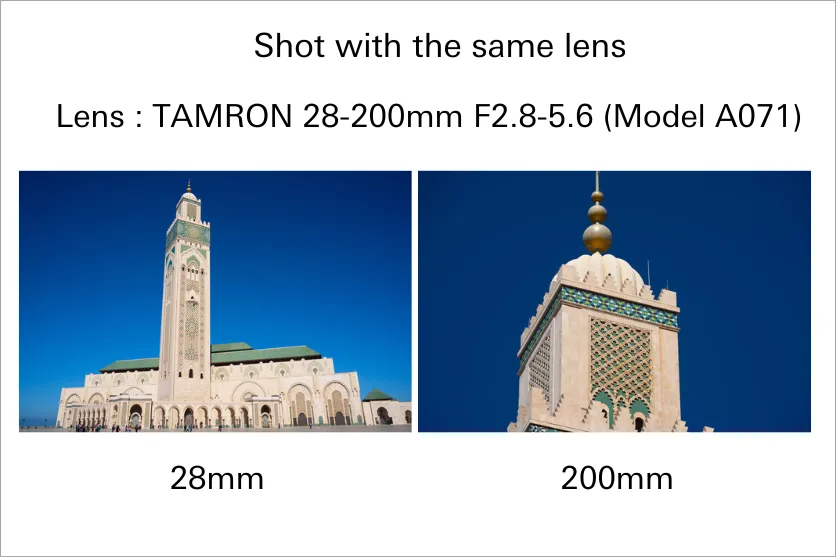September 30, 2024
What is a wide-angle lens? Its features, types and how to choose the right lens
What is a wide-angle lens? Its features, types and how to choose the right lens


The choice of camera lens is one of the factors that greatly affects the quality of photography and the range of expression. In particular, wide-angle lenses demonstrate their potential in a variety of scenes such as landscapes, astrophotography and architecture. But you need to understand the characteristics of wide-angle lenses to make good use of them. That’s why in this article we will go over everything from basic knowledge about wide-angle lenses and detailed explanations about how to choose the right one.
A wide-angle lens is a lens with a wide angle of view that is able to capture a scene over a wide area. Generally speaking, lenses with a focal length of 35mm or less are regarded as wide-angle lenses. As wide-angle lenses not only capture a wide range of a scene but also focus into the distance, they are often used for landscape photography.
Another feature of a wide-angle lens is how perspective is emphasized. This enables photos that have a sense of depth by utilizing compositions with a foreground and background.
For example, the following photos were taken using the TAMRON 28-200mm F2.8-5.6 (Model A071) at its wide and telephoto ends. As you can see, at the wide end, the entire building is in frame, while at the telephoto end the angle of view is focused on one part of the building.
Focal length is the distance from the center of the lens (principal point) to the sensor. Lenses with a short focal length (up to approximately 35mm) are referred to as “wide-angle,” while those with a long focal length (around 60mm or greater) are referred to as “telephoto,” and those in the middle (between 40mm and 60mm) are regarded as “standard.” Particularly in the wide-angle range, in general lenses are further classified as follows based on their focal length.
Most wide-angle lenses cover focal lengths between 20mm and 35mm, allowing users to shoot a wide range of subjects from landscapes and starry skies to portraits. However, in the case of a prime lens, since the focal length is fixed, the photographers need to move back and forward in relation to the subject to find the right composition.
In addition, the ultra wide-angle lens not only captures a wide area, but also enables compositions that capture a wider background while getting closer to the subject in the foreground for a more dynamic shot.
One of the biggest characteristics of a wide-angle lens is its large depth of field (the range over a subject that looks in focus). That is why it is possible to not only render the main subject but also surrounding elements and a distant background in a focused image with a wide-angle lens. This is why wide-angle lenses are regarded as suitable for landscape photography.
Another characteristic of wide-angle lenses is that perspective is emphasized. You can take impactful shots by making use of this effect. However, the peripheral distortion that occurs from a wide angle of view is another point that needs to be considered. Here we will give you a good understanding of these characteristics and provide tips on how to best take advantage of them.
The sense of depth in an image is referred to as perspective. As perspective is emphasized in photos taken with wide-angle lenses, near objects appear larger, and distant objects appear smaller.
The key to take advantage of this effect is being creative with composition. For example, by shooting a building or other structure from off-center or a low angle, you can reinforce the sense of grand scale.
You can also take appealing images with compositions that show a large background against a person or other main subject. For example, while this image is focused on the person pulling the attention on him/her, the background captured in crisp detail brings out the beauty of the main subject.
Due to the characteristics of wide-angle lenses, subjects in the peripheral areas of the image can appear distorted as if it’s stretched. If that kind of distortion becomes a concern, you should adjust the composition so that the main subject is positioned in the center area of the angle of view, or if available, utilize the lens correction feature of your camera body.
From here, we will show some scenes that are best suited to the use of a wide-angle lens. One of the appeals of a wide-angle lens is how you can use the wide angle of view to render magnificent scenes dynamically. A wide-angle lens demonstrates true value in scenarios where you want to capture a landscape in its entirely, such as a range of mountains or a panoramic coastal view.
And if you place a subject front of that scene, you can emphasize the contrast between that foreground subject with the building or landscape in the background, or shoot a tall building from foot-level, creating images with a commanding presence. Let’s capture a variety of subjects using TAMRON wide-angle lenses.
Due to their focal length and wide field of view, wide-angle lenses are ideal for capturing dynamic shots of vast landscapes. The real appeal of a wide-angle lens is its ability to capture the full beauty of nature, whether it is rolling mountains, fields carpeted with flowers, or the ocean stretching as far as the eye can see. Compositions that place a main subject in the foreground at large scale to emphasize the contrast with the background landscape can draw a viewer into the scene in impactful ways.
The ability to capture vast landscapes woven from constellations, galaxies, shooting stars, the Milky Way, and other elements that make up the night sky is another attraction of wide-angle lenses. By incorporating a mountain range or a building in the foreground and utilizing the contrast with the starry sky that extends in the background, you can create a powerful perspective.
Dynamic photos of indoor scenes are another specialty area of wide-angle lenses. With a wide-angle lens, you can photograph spaces with a height or depth that cannot be captured with a standard lens and fit the scene into a single frame. For example, by incorporating an angle looking up from below, you can convey the beauty of impressive structures in an attractive way.
You can also take advantage of the features of wide-angle lenses when photographing cityscapes and streets. For example, by moving closer to a building or vehicle as your main subject and emphasizing the sense of perspective with the cityscape in the background, you can accentuate the presence of the subject. Another impressive composition is one that captures the entire cityscape spread out before you in a single frame. A sweeping view of the landscape with its wide streets, plazas, and buildings folded into one another will dynamically express the atmosphere of the place.

You can also bring out the unique charm of a wide-angle lens for portrait photography. In general, lenses with a standard to medium-telephoto angle of view are commonly used for portraits. However, by using a wide-angle lens to capture a subject within a background, you can produce a clear sense of perspective with the background. You can further highlight the person who is your subject as a result.
Now we will give an easy explanation of how to choose a wide-angle lens. Although the points of importance will vary depending on the shooting scene and other factors, we will focus on"focal length and F-number," "autofocus performance and vibration compensation," and "ease of portability.” We also need to check differences between lens mount types and sensor sizes.
First let’s check whether a lens is a zoom or prime lens. Among wide-angle zoom lenses, choosing a lens that covers the ultra wide-angle range from 16mm to around 20mm will allow you to use a single lens for a variety of situations and expand your range of expression.
F-number is a figure indicating how bright and fast a lens is. A smaller F-number indicates it is a bright and fast lens, which makes it easy to take bright photos even in dark environments. When shooting in situations where there is not much light, such as indoor environments, night scenes or astrophotography, it is best to choose a lens with as small F-number as possible.
Check that the autofocus (AF) feature of the lens can smoothly focus on objects without hassle. In addition, when the camera is equipped with the VC mechanism, it will be easier to handle more shooting situations if the sensitivity of compensation can be adjusted. The availability of good AF features and vibration compensation can help photographers, particularly beginners, take high-quality photos easily.
Lens Technologies: AF technology →
Lens Technologies: VC (Vibration Compensation) →
When you are shooting things like landscapes, you often have to walk long distances and even climb mountains. How light and easy to handle your lens becomes important in these situations. In general, lenses with a smaller F-number or multiple functions tend to be heavier, but TAMRON lenses are known for combining high performance with light weight.
When buying a lens, you will need to check the mount specifications and sensor size of your camera body. As the mount system for attaching lenses to camera bodies vary by camera manufacturer, it is necessary to select a compatible lens.
In addition, sensor sizes for interchangeable lens cameras come in two main types: full-frame and APS-C. As each lens is designed with a specific sensor size in mind, in general it is advisable to attach full-frame compatible lenses to cameras with full-frame sensors, and APS-C compatible lenses to cameras with APS-C image sensors. However, if you attach a full-frame-compatible lens to a camera with an APS-C sized sensor, it offers the benefit of increasing the focal length by around 1.5 times*.
*Whether or not a full-frame lens can be attached to a camera with an APS-C sensor, and the precautions to observe when doing so vary by camera manufacturer. Please check this information before making a purchase.
-

-
17-28mm F/2.8 Di III RXD a046(Model )
The 17-28mm F/2.8 Di III RXD (Model A046) achieves a filter diameter of ø67mm, which is surprising for a large aperture ultra wide-angle zoom lens for full-frame cameras. It’s small and light weight with a good camera balance. It's a dedicated lens for mirrorless interchangeable -lens cameras that can be carried easily and can be used in various situations.
-

-
17-50mm F/4 Di III VXD a068(Model )
The 17-50mm F/4 Di III VXD (Model A068)It's the world’s first lens covering from ultra wide-angle 17mm to the standard 50mm focal length. The highly-compact TAMRON 17-50mm F/4 Di III VXD (model a068) for Sony E-mount full-frame mirrorless cameras offers maximum versatility for still and video creators. From landscapes to living rooms, this lens captures all that you see.
-

-
20-40mm F/2.8 Di III VXD a062(Model )
The 20-40mm F/2.8 Di III VXD (Model A062) is a new large-aperture standard zoom lens that thoroughly pursues portability. While covering the range from the ultra-wide angle of 20mm to the standard range of 40mm, it is the smallest and lightest in its class. It also offers high image quality throughout the entire zoom range, making it useful not only for still image shooting but also for video recording such as vlogging. The VXD, which is quiet and agile, achieves high-speed, high-precision autofocusing. It is a new, unprecedented large-aperture standard zoom lens that allows users to easily enjoy taking out and shooting both still and video.
-

-
28-75mm F/2.8 Di III VXD G2 a063(Model )
28-75mm F/2.8 Di III VXD G2 (Model A063) is the second-generation fast-aperture standard zoom lens for Sony and Nikon full-frame mirrorless cameras, offering significantly improved optical and autofocus performance and new function customization.
-

-
35-150mm F/2-2.8 Di III VXD a058(Model )
The 35-150mm F/2-2.8 Di III VXD (Model A058) is a high resolution travel zoom lens that covers everything from the 35mm wide angle to the 150mm telephoto focal length, the first zoom lens achieving an aperture of F2 at the wide angle end. It has a groundbreaking fast-aperture and utilizes the linear motor focus mechanism VXD (Voice-coil eXtreme-torque Drive), thereby achieving high speed, high precision autofocusing. The innovative lens design enabled us to greatly improve the lens's grip and functionality. The software, developed in-house, enables to easily customize functions and to update firmware.
-

-
28-200mm F/2.8-5.6 Di III RXD a071(Model )
Tamron has distilled all the technical capabilities and know-how amassed over the last 28 years in its development of all-in-one zoom lenses into the creation of this 28-200mm F/2.8-5.6 Di III RXD (Model A071), designed exclusively. The lens has a large maximum aperture of F2.8 at 28mm wide end, which represents a world’s first* for all-in-one zoom lenses, and delivers high-level performance across the entire zoom range, from the 28mm wide-angle end to 200mm telephoto.
-

-
20mm F/2.8 Di III OSD M1:2 f050(Model )
The 20mm F/2.8 Di III OSD M1:2 (Model F050) is a 20mm fixed focal lens featuring F/2.8 and high close-up shooting, allowing you to enjoy ultra wide-angle photography in earnest. With a MOD (Minimum Object Distance) of 0.11m, you can enjoy the world of ultra wide-angle photography that you have never experienced before.
-

-
24mm F/2.8 Di III OSD M1:2 f051(Model )
The 24mm F/2.8 Di III OSD M1:2 is a wide-angle fixed focal lens that allows you to get incredibly close-up. Its focal length is 24mm and the MOD (Minimum Object Distance) is 0.12m. The compact and lightweight design that allows you can shoot light, making it ideal for snapshots.
-

-
35mm F/2.8 Di III OSD M1:2 f053(Model )
The 35mm F/2.8 Di III OSD M1:2 is an F/2.8 large aperture fixed focal lens. The MOD (Minimum Object Distance) is 0.15m. You can enjoy the beautiful bokeh that brings out the subject.
-

-
11-20mm F/2.8 Di III-A RXD b060(Model )
The 11-20mm F/2.8 Di III-A RXD (Model B060) is the world's first compact, lightweight F2.8 ultra wide-angle zoom lens for Sony E-mount APS-C mirrorless cameras. Can be a great choice for video shooting.
-

-
The 17-70mm F/2.8 Di III-A VC RXD b070(Model )
The 17-70mm F/2.8 Di III-A VC RXD (Model B070) is a large-aperture standard zoom lens for APS-C format mirrorless cameras. With a focal length range of 17mm to 70mm (a full-frame equivalent of 25.5-105mm) for daily use, this achieves a 4.1x zoom. The optical design ensures high resolution and high contrast not just in the center of the image but also in corners and at the edges. The quiet AF drive motor and the VC image stabilization mechanism facilitate hand-held shooting. In addition, by counteracting focus breathing, the 17-70mm F2.8 empowers users' expression of their creative intentions to the fullest degree. This highly practical lens allows you to easily enjoy the high image quality of a large F2.8 aperture for both still and video shooting.
By taking advantage of their features, wide-angle lenses enable a wide range of photography from dynamic landscape images to portraits. By getting creative with different angles of view, perspective effects and composition, you can enjoy taking photos that take full advantage of the appeal of wide-angle lenses.

Lens Featured in this Impression
-

-
11-20mm F/2.8 Di III-A RXD b060(Model )
Product Page | 11-20mm F/2.8 Di III-A RXD (Model B060) is the world's first compact, lightweight F2.8 ultra wide-angle zoom lens for Sony E-mount APS-C mirrorless cameras. Can be a great choice for video shooting.
-

-
16-30mm F/2.8 Di III VXD G2 a064(Model )
Expanding upon the success of the highly acclaimed TAMRON 17-28mm F/2.8 Di III RXD (Model A046), the G2, 2nd-generation emerges as an advanced 16-30mm F/2.8 Di III VXD G2 (Model A064). While broadening the zoom range, it maintains a compact, lightweight design and delivers exceptional image quality. In addition, it features improved autofocus performance and has been updated to the latest lens design, enhancing overall operability. It’s also compatible with TAMRON Lens Utility™, allowing you to customize practical functions for both photography and videography. Retaining the mobility and versatility of its predecessor, the 16-30mm F2.8 G2 unlocks new creative possibilities. Experience the unique creative expressions that only a fast, ultra wide-angle lens can offer.
-

-
17-50mm F/4 Di III VXD a068(Model )
It's the world’s first lens covering from ultra wide-angle 17mm to the standard 50mm focal length. The highly-compact TAMRON 17-50mm F/4 Di III VXD (Model A068) for Sony E-mount full-frame mirrorless cameras offers maximum versatility for still and video creators. From landscapes to living rooms, this lens captures all that you see.
-

-
20-40mm F/2.8 Di III VXD a062(Model )
The 20-40mm F/2.8 Di III VXD (Model A062) is a new large-aperture standard zoom lens that thoroughly pursues portability. While covering the range from the ultra-wide angle of 20mm to the standard range of 40mm, it is the smallest and lightest in its class. It also offers high image quality throughout the entire zoom range, making it useful not only for still image shooting but also for video recording such as vlogging. The VXD, which is quiet and agile, achieves high-speed, high-precision autofocusing. It is a new, unprecedented large-aperture standard zoom lens that allows users to easily enjoy taking out and shooting both still and video.








